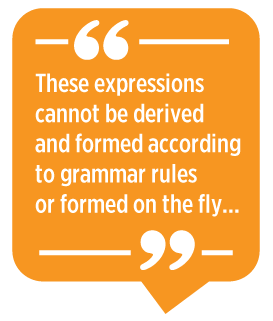
Multiword expressions are combinations of words that frequently occur and reoccur together in discourse and text of any kind. These can be laborious for multilingual learners to learn and use correctly because they consist of two or more component parts. Some examples of multiword expressions: from time to time, traffic light, give out, hand out, call out, on the other hand, have for lunch, take a walk, open up, close down, in any case, just in case.
There are more than 40 terms that refer to these expressions (and more according to some counts). Some examples include multiword units, chunks, collocations, phrases, idioms, expressions, formulaic sequences, formulaic language, prefabricated constructions, and lexical bundles. All these are included in the blanket term multiword expressions.
Multiword expressions can be taught at practically any language proficiency level, and they can be found in any type of language use. Some phrases can be rigid and inflexible, and these do not allow much room for variation (e.g., few and far between, get a handle on, thank you, out of luck, out of the park, out and about, in a pickle). Others can be variable and thus permit component substitutions. Here are some examples:
-
the [purpose/aim/goal] of this [paper/essay/study]
-
a careful [examination/analysis/discussion]
-
see you [tomorrow/later/next week/at the xxx/on the other side]
-
an important [aspect/point/issue/consideration]
Teaching multiword expressions can be relevant anywhere in the world and in any learning context. The pointers covered here include the following:
-
teaching and learning multiword expressions explicitly
-
effective and ineffective classroom teaching techniques
-
using a corpus-based approach for teaching
The Biggest Knots
1. Unpredictability and Irregularity
Many recurrent word combinations can have unpredictable meanings and grammatically irregular structures. These expressions cannot be derived and formed according to grammar rules or formed on the fly (this is a multiword expression) in the process of communication.

Noticing their occurrences and components is very important for learners to increase their linguistic repertoire, fluency, and proficiency. Most proficient first language and second language users attain their facility with hundreds and thousands of phrases over time and through encountering them in all manner of interactions, reading, and writing (Hinkel, 2019, 2023; Nation, 2022).
2. Identifying Prevalence
One of the key issues with multiword phrases is that they are extremely frequent. Some researchers have claimed that “up to 70% of everything we say, hear, read, or write is to be found in some form of fixed expression” (Hill, 2000, p. 53). Others have counted their occurrences in the hundreds of thousands.
However, without explicit instruction, most language learners cannot always identify the occurrence or prevalence of multiword units in either spoken or written English and, in part for this reason, have restricted opportunities of learning how and when to deploy them in language comprehension or production.
Effective and Practical Teaching Strategies
A key technique is to bring learners’ attention and deliberate learning work to focus on the grammatical elements of multiword expressions—their uses, forms, and structures (e.g., the order of the language elements, singular and plural markers, articles, and prepositions). In this, the teacher’s guidance is essential.
In general terms, a few key factors lead to any type of vocabulary learning and language gains, be it single-word or multilingual expressions:
- repeated encounters
- spaced repetition and review at regular intervals (review, review, review)
- purposeful and deliberate attention, work, and practice (and practice)
Indeed, for adult learners, a strong and significant learning advantage can be obtained with at least 10 to 15 repeated exposures and follow-ups.
Ineffective Teaching Techniques
Although learning single-word vocabulary is easier than learning multiword constructions, in many ways, the techniques for teaching and remembering them do not differ greatly.
In gist, the following teaching techniques have been found to be less than effective in the teaching and retention of multiword expressions:
-
Fill-in-the-blank practice leads to particularly poor learning and retention and results in limited usage in production.
-
Without deliberate attention and focus on the grammar components of phrases, incidental learning of multiword constructions typically results in low language gains and very little learning (Boers, 2021; Hinkel, 2019; Nation, 2022).
-
Providing insufficient review and too few repeated exposures represents one of the most pervasive ineffective instructional strategies.
Discovery Tasks: Searching for Patterns
Though there is an abundance of resources for second language vocabulary and grammar teaching and learning practices found in the literature, one approach for multiword expressions is to engage learners in corpus-based learning tasks. Corpus-based learning incorporates a natural inductive approach to vocabulary and grammar learning. In this approach, learners are shown lines of text and asked to “discover” and then later describe the patterns they see. This approach taps into something that humans have evolved to become quite good at, which is the ability to detect patterns and then apply them to new situations (see Boulton, 2007).
This approach is a significant departure from the older, traditional notion that rules should be presented, practiced, and then produced. We are now asking students to observe language data, look for patterns, formulate a hypothesis, and then apply newly formed understandings in their language production.
Following, we describe a few corpus-based activities that we ask our students to do as they work on acquiring multiword forms in our academic English program.
Vocabulary Worksheet
-
Examine course texts and pull out key academic vocabulary words in their original contexts and paste them into a worksheet (see Appendix A for an example).
-
Next, ask the students to complete a number of corpus-based tasks using an academic web-based corpus. (We use the Corpus of Contemporary American English [COCA] because of its relative ease of use.) You may need to create videos to show them how to complete the worksheet. Each task has a response column in the worksheet. For example, they look for and write down
- frequent words before and after the target word,
- the part of speech,
- other forms of the words,
- synonyms,
- a definition, and
- clusters (words that cluster one, two, and three positions left and right of the word).
-
The final task requires the students to use the information they have been discovering to write an academic sentence of their own with an emphasis on including frequent words before or after and/or clusters in their own sentences.
-
You can then check their accuracy of use by looking for the target vocabulary with acceptable multiword forms in students’ oral presentations and written assignments. We usually require they use at least five of the target words in each class larger production assignment.
Speaking Practice With Multiword Expressions
Another approach to teaching multiword expressions via corpora is to point out how words are linked in grammatical constructions. For example, in speaking classes, we can explain how thought groups or intonation units (Celce-Murcia et al., 2010) typically occur as multiword forms. In the table, we can see examples of how thought groups form semantically and grammatically coherent multiword units of discourse. Teachers can create a worksheet (see Appendix B) that requires students to explore these patterns in corpus data and practice using them by asking them to write and then perform conversations which contain these forms.
Table. Common Grammatical Forms in Thought Groups
|
Article + adjective + noun |
the other hand, the present study, the United Nations, a wide range, a great deal |
|
Article + noun + verb |
the results indicated, the court held, the authors declared, the study reported |
|
Preposition + article + noun |
in the context, in the graph, on the basis, in the study, of the students |
|
Relative pronoun + noun + verb |
which students learn, which individuals experience, whose parents reported, that people want |
|
Subordinating conjunction + noun + verb |
because people know, as children develop, after researchers applied, as evidence suggests |
|
Verb + adverb |
carried out, described above |
|
Verb + direct object + preposition + indirect object |
hand it to him, reminds us of her, prepares them for careers |
|
Verb + object |
make sense, eat lunch, solve problems, anticipate errors |
Conclusion
Teaching learners to examine larger pieces of discourse broken into thought groups along semantic and grammatical categories can raise consciousness about multiword patterns and their uses as they occur in spoken and written language.
Overall, we have found corpus-based activities to be quite useful in helping facilitate the acquisition of multiword expressions in our classrooms. Our hope is that teachers can tap into corpus tools available to help their learners examine the multiword patterns that are used in their spoken and written interactions in various settings with others and begin using them correctly in their own spoken and written discourse.
References
Boers, F. (2021). Evaluating second language vocabulary and grammar instruction: A synthesis of the research on teaching words, phrases, and patterns. Routledge.
Boulton, A. (2007). DDL is in the details…and in the big themes. In M. Davies, P. Rayson, S. Hunston, & P. Danielsson (Eds.), Proceedings of the Corpus Linguistics Conference (pp. 1–13). University of Birmingham, UK.
Celce-Murcia, M., Brinton, D. M., Goodwin, J. M., & Griner, B. (2010). Teaching pronunciation: A course book and reference guide (2nd ed.). Cambridge University Press.
Hill, J. (2000). Revising priorities: From grammatical failure to collocational success. In M. Lewis (Ed.), Teaching collocation: Further developments in the lexical approach (pp. 47–69). Language Teaching Publications.
Hinkel, E. (Ed.). (2019). Teaching essential units of language: Beyond single-word vocabulary. Routledge.
Hinkel, E. (2023). Teaching and learning multiword expressions. In E. Hinkel (Ed.), Handbook of practical second language teaching and learning (pp. 435–448). Routledge. [Available at http://www.elihinkel.org/downloads.htm]
Nation, P. (2022). Learning vocabulary in another language (3rd ed.). Cambridge University Press.
|
Download this article (PDF) |
Eli Hinkel has taught applied linguistics and teacher education courses for more than 35 years. She has published numerous books and articles on learning second culture, grammar, writing, and pragmatics in such journals as TESOL Quarterly, Applied Linguistics, Journal of Pragmatics, and Applied Language Learning. She is also the editor of the Routledge ESL & Applied Linguistics Professional Series of books and textbooks for teachers and graduate students.
Brent A. Green is a professor of English language teaching and learning at Brigham Young University–Hawaii. His interests include language assessment, corpus-based approaches to learning, and ESL/EFL pedagogy. He has taught EFL/ESL, TESOL, developmental education, and linguistics courses in the Marshall Islands, Taiwan, Utah, Tonga, Samoa, California, and Hawaii.
